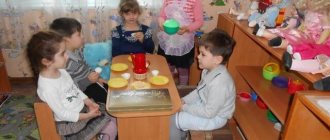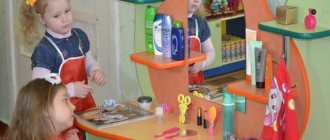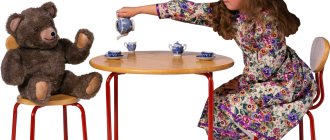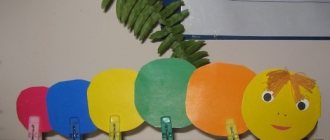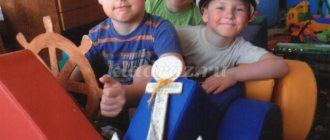Progress of the game:
Today the zoo came to us. At the zoo you can see different wild animals! Hurry, hurry!
There are funny animals at the zoo.
Part 2: I give children tickets to the “zoo”
.
Part 3:
- Guys, which of you was in the “zoo”
?
— Tell me, what is a zoo?
ZOO – a zoological park, a place where you can see different animals. They were brought from different countries.
— Who takes care of the animals in the zoo?
(Human)
.
- What else is he doing at the zoo? (protects, protects)
.
— What is our mini-zoo made of? Does this mean which one? (small)
.
— And so that the animals do not run away, what has been done for the animals (enclosures)
.
— What are the enclosures made of? (from Lego)
.
— A very beautiful zoo. Large and spacious.
- Let's see what animals live in our zoo? (children list)
“Our animals came to us from hot countries where it is warm in winter, and they will be cold here.
- What do you think needs to be done so that they can survive our cold winter? (build them houses)
.
— I suggest you build houses from wooden building material.
We built houses for animals. Now they are not afraid of our harsh and cold winter.
— Did you like the game at the zoo?
— Which animals piqued your interest?
—What animals would you not like to meet in the forest?
— Do you think wild animals need our help, like domestic animals?
— Why can’t you have wild animals in your apartment?
Our tour of the zoo is over, but we will come here again.
Card No. 12 “Professions”
Goals: to develop children's interest in role-playing games , to help create a play environment; enrich vocabulary, consolidate sound pronunciation; to develop in children the ability to use building floor materials and act with them in a variety of ways; consolidate previously acquired knowledge about the work of a doctor, seller, hairdresser; cultivate friendly relationships in the game.
Progress of the game:
A teacher-doctor acts out a dialogue with a bunny-patient (child)
.
Doctor. The hospital opens. I am a doctor. Who came to my appointment?
Bunny patient (complaining)
.I am doctor.
At the doctor's office, sit down, patient. Tell me exactly where your pain is concentrated?
Patient. I have a cough and my ears hurt.
Doctor. Let me listen to you. Breathe deeply. (Listen to the patient with a tube.)
You are coughing a lot.
Show your ears. My ears are inflamed. Now we need to measure the temperature. Take a thermometer. High temperature. You need to take medicine. This. (gives a bottle.)
Pour into a spoon and drink every day. Did you understand?
Patient. Yes. I will take the medicine as you ordered. Thank you Doctor. Goodbye.
Card No. 14 “Katya got sick”
Goals: to diversify children’s role-playing participation in playing with a doll; contribute to enriching the plot of children's games ; develop children's speech and enrich their vocabulary; help children establish interactions in joint play; cultivate friendly relationships in the game.
Materials and equipment: spatula, phonendoscope, thermometer, medicines (substitute items are used)
;
doctor's bag, gown, cap (2-3 copies)
.
Progress of the game:
The teacher informs the children that today is Stepashka’s birthday and offers to go visit him and congratulate him. The children take their toys, go to visit Stepashka and congratulate him. Stepashka offers everyone tea and cake and asks them to help him set the table. Children actively participate in this and, with the help of the teacher, set the table. process of the game.
Card No. 4 “Getting ready for a walk”
Goal: to develop in children the ability to select clothes for different seasons, to teach them to correctly name elements of clothing, to consolidate the general concepts of “clothing”
,
“shoes”
, cultivate a caring attitude towards others.
Equipment: dolls, clothes for all seasons (summer, winter, spring and autumn, a small wardrobe and a chair.
Progress of the game:
The teacher puts him on a car (made in advance from large building material)
Katya doll. Says:
-the doll wants to ride in a car. Who will be the driver?
-Thank you, Sasha, you were a good driver. Look, more guys have come to see you. They also want to play their toys. How do you ask Sasha about this? (Sasha, please give my Sveta a ride.)
-And so that you don’t have to wait long, let’s ask Vanya to be the driver too. Let's help him build a car. You bring us cubes and bricks, and Vanya and I will build. Invite passengers.
Card No. 11 “Zoo”
Goals: to ensure children's interest in role-playing games , to help create a play environment; teach children to distinguish the characteristic features of the appearance of wild animals; develop speech, enrich vocabulary, consolidate sound pronunciation; introduce the behavioral characteristics of these animals; contribute to the expansion of knowledge about animals, their appearance, characterize them from memory; fostering a kind attitude towards animals, love for them, care for them, friendly relationships in the game.
Equipment: building material (large, small Lego, a set of animals, a white coat for a doctor, a thermometer, a phonendoscope, a first aid kit, a cash register, tickets.
Progress of the game:
The teacher says that the dolls want to go for a walk.
-Let's put them on for a walk. And we will ask our boys to build paths, a train, a car, a slide for our daughters, so that everyone will have fun and interesting while walking.
Children dress dolls.
The teacher asks who will build what for the dolls and what. During construction, he assigns the names of construction parts, their size, color, and encourages children’s independence and friendly play. If necessary, helps dress dolls for walks.
When the dolls are dressed and the buildings are ready, you can invite the children to walk along the paths with the dolls.
When the game is repeated, the construction of one or two new, more complex buildings is introduced. The teacher gives an example of playing with them not only with dolls, but also with other figurative toys (if you put a skirt and scarf on the pin, you get a matryoshka doll)
.
During such games, the teacher gradually leads children to joint play activities.
Card No. 9 “Bathing a doll”
Goals: to teach how to combine games with a single plot : first, the doll must be undressed, bathed, dressed, put to bed, correctly named objects and their purpose; consolidate a variety of game actions; develop gaming skills; enrich vocabulary; cultivate respectful attitude towards each other and careful attitude towards toys.
Equipment: bath, soap (brick, soap dish, towel, ladle (all items in 2-3 copies)
;
Katya doll (her are “dirty”
).
Progress of the game:
The teacher, turning to the doll, asks:
Oh you dirty girl
Where did you get your hands so dirty?
Then he speaks to the children.
-The Katya doll got dirty. We need to buy it. What do we need for this?
When washing the doll is finished, the teacher invites Elya to dry it with a towel.
-The doll has become clean.
Then the doll is dressed and put to bed.
The game can be repeated 2-3 times with the involvement of children who have a low level of gaming skills.
Card No. 10 “Let's take the dolls for a ride in the car”
Objectives: to introduce children to the profession of a driver and the rules of safe travel on transport; teach children to unite 2-3 children for independent games, lead children to independently conceive game plots ; continue to develop the ability to transfer familiar actions with building materials to new game situations, perform actions in accordance with the role (driver, passenger)
; to cultivate interest and respect for the driver’s profession, the desire to comply with the norms of behavior in public transport.
Equipment: a set of building materials (cubes, plates, bricks, steering wheels (2-3 pieces), dolls, shaped toys (bear, hare, fox, in the construction corner the teacher has built a car in advance.
Progress of the game:
A new doll comes to visit the children. She meets them and wants to play. But the guys are going for a walk and invite the doll to go with them. The doll complains that she can’t get dressed, and then the guys offer her their help. Children take out doll clothes from the locker, name them, choose what they need to wear now depending on the weather. With the help of the teacher, they dress the doll in the correct sequence. Then the children dress themselves and go out for a walk with the doll. Upon returning from a walk, the children undress themselves and undress the doll in the required sequence, commenting on their actions.
Card No. 5 “Travel with Doctor Aibolit”
Goals: continue to work on developing and enriching the plots of games ; introduce children to the medical profession; teach children game actions, their implementation in a certain sequence: inspection, listening with a tube (phonendoscope)
breast, back, temperature measurement with a thermometer, treatment with tablets;
develop auditory attention, perception, memory by naming objects for treating the doll, remembering the sequence of treatment; teach to give in and exchange toys and roles; to cultivate a caring attitude towards a sick doll, interest and respect for the medical profession; strengthen the ability to perform game actions.
V-l: Children, you and I are going on an interesting journey. Do you want to travel with me? (Yes)
.
V-l: Oh, who came to us? (Children's answers)
.
That's right, this is the good doctor Aibolit. Let's say hello to him and smile at him. (Addresses Aibolit)
. Doctor Aibolit, what happened?
D.A.: The doll Masha got sick,
I didn’t eat semolina porridge,
We need to treat Masha,
Put him to bed in bed.
Vs.: Oh, I’m sorry for Masha, she’s sick.
D.A.: And to cure Masha, you need my magic suitcase, and I left it somewhere.
V-l: We need to help D.A. cure Masha, let’s go to kindergarten and look for him there. (We overcome obstacles like a stream, pebbles, etc.)
And here is your magic suitcase.
Card No. 6 “Bake pies”
Goal: to introduce children to the process of making pies and safety rules in the kitchen; teach to set game goals, perform appropriate game actions, find objects necessary for the game in the environment, lead children to independently create game plans; develop gaming skills and abilities, enrich vocabulary; cultivate respect for other people's work; consolidate the ability to unite into groups in the game , perform game actions.
Equipment: kitchen utensils, dolls, building kit parts (small balls cut in half, substitute items
Progress of the game:
Educator:
We build cribs, a chair, a tap for washing hands, and set the table. We carry the cubes one at a time, without disturbing anyone. The doctor, hairdresser and salesman go to their work. And the rest of the kids take care of their children. (I help develop the game, establish relationships between those who have chosen certain roles, and help implement into the game the impressions the children received earlier.)
A certain amount of game time passes.
Educator:
Evening has come in our town, the working day is over, the hospital, hairdresser, and store are closing. We put everything back in place.
All the kids did well, tell me, who were you today, Vanya? How did you take care of your son? Where did you go with him? Dasha, what did you feed your daughter? Julia, which bed did you put your daughter to sleep on? What kind of doctor was Kirill? Hairdresser? Salesman?
Card No. 13 “Hospital”
Goals: continue to introduce children to the professions of doctor and nurse; arouse interest in the professions of medical workers; develop children's speech and enrich their vocabulary; help children establish interactions in joint play; cultivate a sensitive and attentive attitude towards the patient, kindness, responsiveness, and a culture of communication.
Equipment: medical cards according to the number of children , a toy phonendoscope, a spatula, an ENT mirror, a thermometer, brilliant green, a table, 2 white coats for a doctor and a nurse, 2 white caps, cotton wool, a bandage, a syringe.
Progress of the game:
The teacher says that today is Katya’s doll’s birthday and she invites you to visit. Advises the children to think about what they will give Katya, how they will please her. He suggests that they can come to visit with a bear and bring a barrel of honey or with a bunny who will give Katya a delicious sweet carrot.
Then the teacher invites the children to help Katya beautifully set the table for the guests and prepare tea.
Children are going to a birthday party.
When repeating the game, you can celebrate the birthday of a bear, bunny, cat, etc.
Card No. 8 “Dolls for a walk”
Goals: continue to develop interest in playing with dolls and building materials; learn to use acquired skills in the construction of simple buildings; consolidate the ability to play together, share game material; develop children’s desire to establish relationships in play and enrich their vocabulary; cultivate interest and respect for each other, the desire to comply with norms of behavior; consolidate the ability to distribute roles; encourage children's independence.
Equipment: a set of large building materials: bricks, cubes, prisms, plates, dolls of different sizes, cars of different sizes, shaped toys: nesting dolls, hares, bears.
Progress of the game:
Voss: -Children, do you want to play with me? I will bake pies. Look what I have (takes the lid off the box and puts it next to it)
.
-I will knead the dough for pies. That's it, that's it! (Mixes parts from the builder in the box.)
What do you like pies with? With jam? This pie is for you, it’s with jam (shows how to make a pie)
.
-Oh, where should I put the pies? What are we going to bake them on? (It’s good if one of the children guesses that you can use the lid of a box lying on the table for this.) Indeed, you can put pies here! Let it be a baking sheet, like in mom's kitchen.
-Sonya’s pie with jam will be here. What does Serezha like with his pie? Do you want it with cabbage or apples? Here it is, a pie with apples and Elya is making a pie, and Albina.
-We still have room, let's make another pie. Who will help me?
-Polina, knead the dough. That's how you get good at it!
-Now make a pie like I do. Place it on a baking sheet. (Offers to other children.)
There were a lot of pies. There is not a single free space left. You have to put it in the oven and let it bake. Where will we have the oven?
-Olya, where are we going to bake pies? Here? (You can use any substitutes.)
Is this a stove? Turn it on quickly! They put out the pies.
- How are our pies?
-Smell how delicious it smells.
-Olya, look, are the pies already browned?
-Of course they are ready. I'll take them out of the oven now. Be careful, it's hot!
-Help yourself. Whose pie is this? Tasty?
(I distribute pies to everyone. If the children take the “pie”
in your mouth, stop them.)
These pies turned out delicious.
We ate, but the dolls remained hungry. They want pies too
Card No. 7 “Doll Birthday”
Goals: to introduce children to the rules of table setting, table manners, and tableware; teach how to correctly find and select utensils for tea drinking;
continue to enrich the content of games; promote the unification of children for joint games; enrich vocabulary; cultivate a desire to observe norms of behavior at the table, respectful attitude towards each other.
Equipment: teaware, tablecloth, doll in an elegant dress, figurative toys (bear, hare, barrel of honey, carrot. You can use substitute items.
